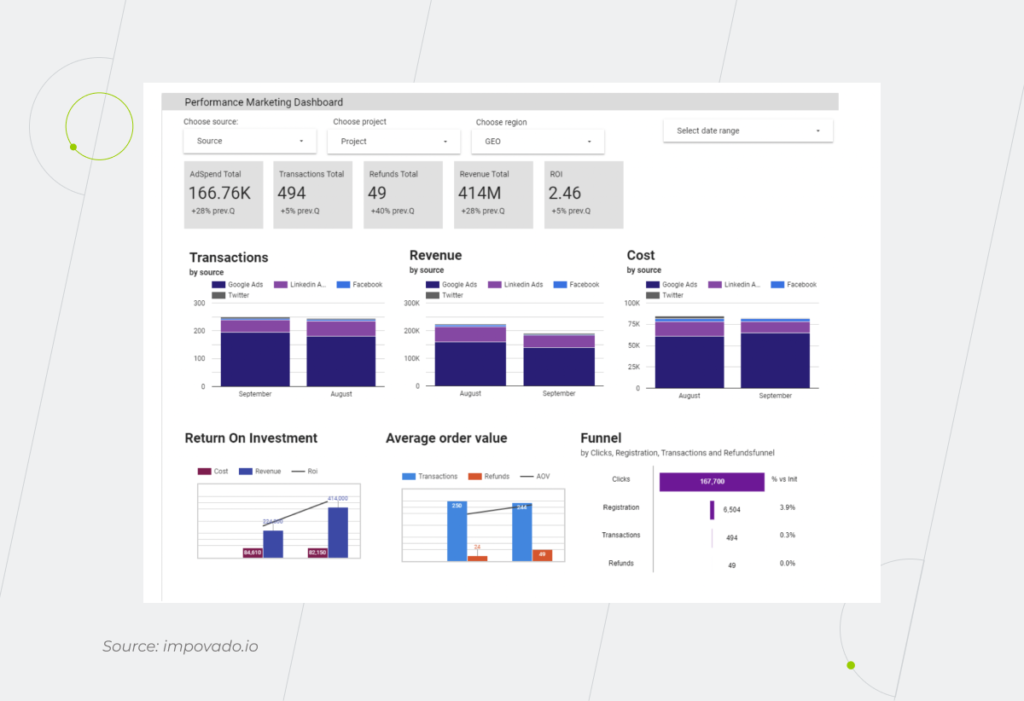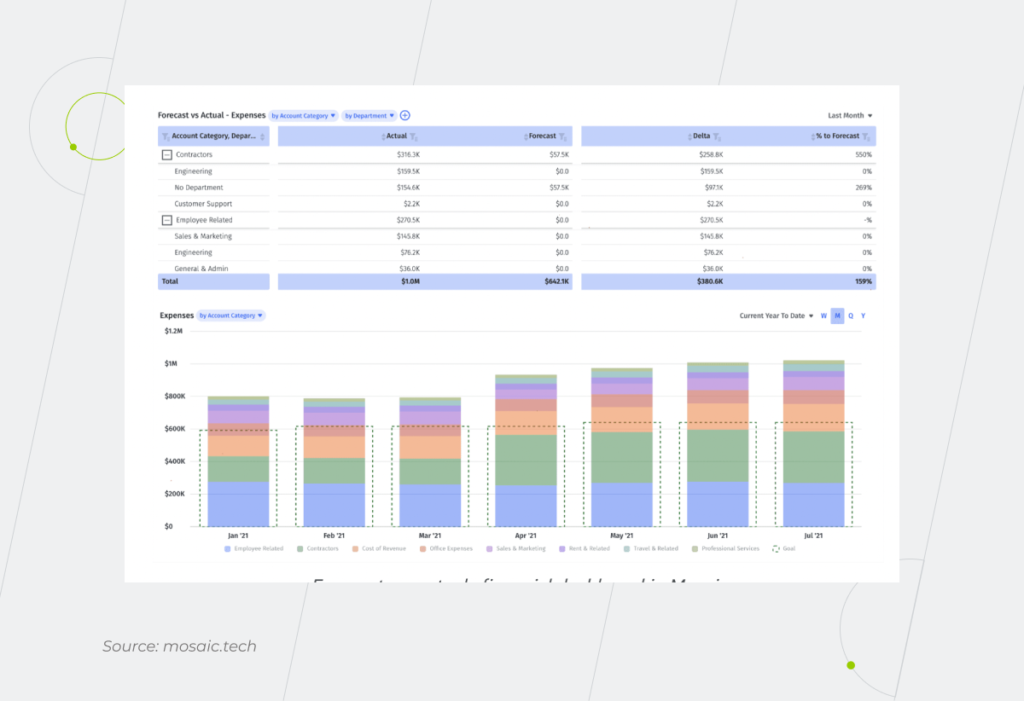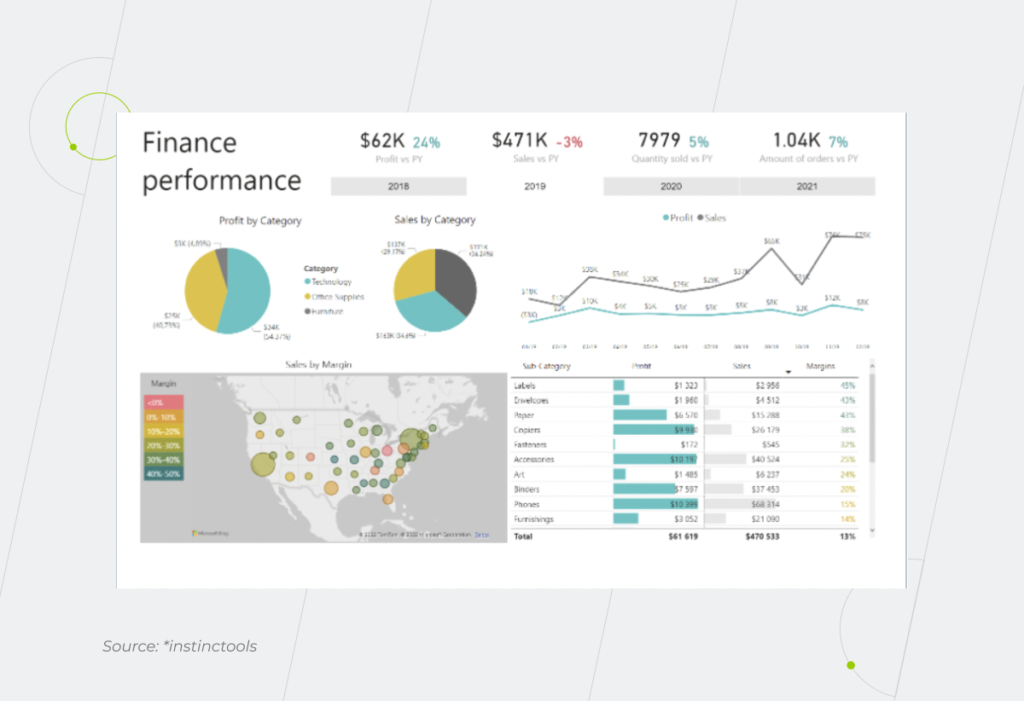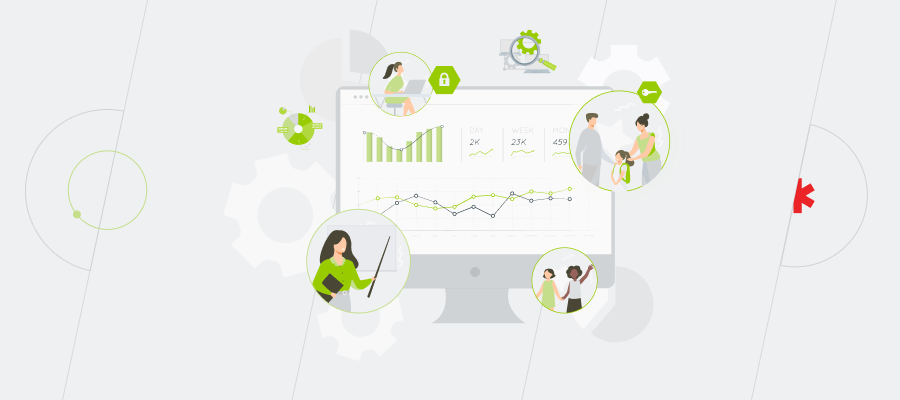Contents
What finance departments certainly have an abundance of is data. It comes from everywhere: spreadsheets, invoices, journal entries, and whatnot. A real treasure, right? Unfortunately, a lot of data by itself does not guarantee that you will be able to unlock all its hidden potential without sacrificing operational efficiency. Forrester reports that up to 73% of enterprise data goes unused for analytics. So what can be done to change the status quo and leverage data from heterogeneous data sources for getting actionable insights and your business growth? Financial Business intelligence addresses finance leaders’ needs for dynamic modeling, holistic data analysis, and accurate planning.
What is so wrong with spreadsheets?
Many CFOs are still not ready to trade Excel for BI tools in finance, guided by the logic of not touching a system that already works. But does it? Spreadsheets have been used for keeping records and conducting data analysis for so long that it’s not even questioned whether or not they are worth it.
However, there are plenty of rationales why you should no longer rely on moss-grown solutions for financial reporting and consider tapping into new alternatives, such as business intelligence software.
One of the main reasons for this is susceptibility to human errors. According to various studies, 9 out of 10 spreadsheets contain mistakes, This is not surprising at all, given manual data entry. Even something as small as a misplaced decimal point can lead to huge accounting distortions.
Another problem with spreadsheets is that they provide a static view of historical data, so putting them to work across complex and dynamic processes is quite a useless idea. A holistic business vision cannot fit into dry financial statements and end-month reports – translating them into actionable insights is a painful undertaking.
The constant changes in the financial landscape leave businesses with no choice but to quickly assess these alterations and act on them. In these conditions, ignoring a wealth of data stored in your enterprise systems is not just unwise but can be devastating. The question is can you take advantage of the raw data locked in spreadsheets? Skimming through hundreds of pages of traditional reports is hardly a good way to gain control over your numbers.
In addition, manual number crunching takes too much time, which, along with taking up your employees’ precious time, leads to the inability to make informed decisions quickly.
Employees might spend 3-5 days a month filling out some crazy Excel spreadsheets. And then, there’s versioning, which, after changing a single digit or moving working files to other shared folders, or after sharing a final presentation file with some links to the working files, involves running through a dozen other files to make sure everything fits. But what if the specifics of your business require you to make well-informed decisions more often than on a monthly or even weekly basis? At the same time, no one is immune to force majeure, which is not scheduled and calls for immediate actions.
— Maxim Hayan, Finance Business Partner
Finally, spreadsheets do not correlate with the financial planning process making it hard for the finance office to get a clear perspective of the current situation and to take forward-looking actions.
Conducting plan vs actual analysis, calculating variance, extrapolating data – all this is very challenging to do in Excel. It’s enough to change the slightest detail for the whole thing to collapse instantly. In addition, it’s incredibly inconvenient. If you use Pivot tables, they tend to overlap, so it’s hard to imagine what they will look like in fact. No wonder adding data for new analysis or reporting periods in Excel files and fine tuning all Pivot tables and charts become utterly discouraging.
— Maxim Hayan, Finance Business Partner
The explanations above as to why spreadsheets hinder the work of the finance department are already sufficient to lean toward BI in finance. This technology is capable of outstanding things. Keep reading to find out more about how it drives finance and accounting tasks and what exactly makes Business Intelligence so attractive for financial services.
Behind the pretty pictures: a detailed look at the benefits of financial Business Intelligence
There’s an opinion that BI is first and foremost a way to present data. Yet, outstanding data visualization is far from everything financial Business Intelligence tools can offer. To put it clearly, the visuals are just a nice-to-have feature in comparison to another kind of new opportunities and value this technology brings to your organization.
If it was just a matter of visualization, it wouldn’t be the sticking point at all. For example, Excel’s modeling capabilities allow presenting charts and graphs too. However, compared to Business Intelligence applications in finance, its limits, such as data size restrictions, poor collaborative functions, and others, are quite significant.
What finance departments cry out for is something faster, something ‘click-of-a-button’ to get updates and predictive analytics in next to no time, something like BI tools for finance. When you implement technology using a thoughtful strategy, what can you expect to gain?
1. Deep stakeholder engagement
The incomparable advantage of BI financial services is that they provide a genuine stakeholder involvement in the “process”, namely long-term financial planning, budgeting, forecasting, and comparison with reality. For instance, if a branch manager has a clear understanding between an input (certain indices, plans for sales volumes, etc.) and an output, it allows for more effective conversations within the department. With self-service BI tools, like Power BI, Tableau, or Qlik, that Gartner mentions among the leaders in the field of data analytics, questions that arise in meetings are addressed and answered immediately. There is no need to go back to the analysts to prepare another report and postpone the discussion until the next time.
Moreover, access to BI solutions via mobile devices and tablets also boosts the business leaders engagement – making financial data analysis more accessible; anytime, anyplace.
2. Time saved. A lot of it
Long gone the time when companies had no other alternatives than to use several Excel files, matching and filtering them manually to get a comprehensive picture of data. Now, the alternative is here and it’s Business Intelligence in finance, which provides incomparably faster report preparation and, thus, operational efficiency. Instead of almost a week to compile the data, it takes no longer than a leisurely cup of coffee and frees up several full days for intellectual work.
Couple that with the fact that there are some businesses where you can’t afford to wait until the end of the month to make a decision. For example, if you’re dealing with fast-moving consumer goods, to survive, you have to keep your finger on the pulse and an eye on your competitors. Otherwise, your analytics are pointless.
BI allows you to see and quickly grasp operational data such as, let’s say, the results of marketing campaigns. The contribution turned out to be twice as much as the investment? Perfect! All you have to do is to analyze exactly what caused this and move forward in the same direction. Whereas an in-the-red campaign serves as an obvious sign to change the strategy or, at least, make some adjustments. There are also such things as tracking bad-selling items, or low-margin ones. It’s difficult to do this in Excel, especially if you have many product lines and ten, fifteen, twenty thousand positions in the assortment.
— Maxim Hayan, Finance Business Partner

3. Consolidated location for your data
Imagine, how much more value a finance department can bring by analyzing the data and offering solutions, rather than spending eons on scrambling for the information on operations, supply chain, HR, procurement, sales and, well, you name it. Thanks to a full-scale BI system, financial data from all over the company and beyond – speaking of Big Data – is gathered in one place.
There are companies that have to pull raw data from a whole set of disparate systems, which in itself is a pain, not to mention that some of these systems might be outdated. Complete re-engineering of legacy software will take years and cost millions. So working with data is handled in any way possible: somebody uses FTP to transfer files, others upload CSV files into certain folders… But what if the folder is changed or the IT team rebooted the server? No wonder the output is messed up. Meanwhile, a well-designed, full-fledged BI system helps to organize this data correctly with a data warehouse or data lake and an ETL process in one place.
— Maxim Hayan, Finance Business Partner
With Business Intelligence for a finance department, employees get the capability to quickly incorporate new data into the data warehouse and interact with all the necessary information in one location without having to search for additional data. Imagine, you can have all your data sources such as the web, SQL Server, Excel, and flat files funneled into a pre-configured solution, where this data is stored, processed, and visualized.
There’s no longer a need to juggle dozens of open tabs and separate reports to tell a story. Whatever data you want to put together, finance business intelligence software allows you to do it without a hitch. For more details, it’s just enough to drill down into the source report.
4. Self-sufficiency
The problem might not even be bringing data from different sources together. You may have a data warehouse and an in-house development team dedicated to helping users with managerial reporting. But that still won’t keep you out of going through all the circles of corporate IT hell while drawing up the terms of reference as many times as it takes for your needs to be understood, and you may still end up with something that doesn’t fully work. BI in finance, on the other hand, helps you unlock the full potential of your data – the kind you never knew you had – without involving the IT department.
5. Effective financial management
By providing robust financial business analytics wrapped in dashboards, the BI tool makes financial management more efficient on all fronts.
- Cash flow management
Cash flow is crucial in non-ideal conditions in which current business has to function – when one crisis is followed by another. Some clients ask for extended terms, and others just slow down payments… With finance business intelligence, you will have visibility into your cash flow and make accurate forecasts to improve its health.
Oftentimes, companies go bankrupt not because they are unprofitable, but because they have a cash deficit. Cash flow management is the top priority for any CFO. In this way, all businesses that work to order and where the production cycle is long enough are unlikely to be able to do without BI financial services.
— Maxim Hayan, Finance Business Partner
For example, with the Cash Overview report in Power BI, you’ll get a grasp of inflows and outflows in system currency, total bank balance and balance by legal entity, today’s actual vs forecasted balance, and more. Meanwhile, cash flow forecasting itself allows you to go into more detail and get daily forecast summaries and actionable data insights.
- Revenue management
The mission-critical questions like what, when, and who to sell as well as what price to set can be answered more easily and accurately when the data is collected, interpreted, and visualized by a financial BI system.
Finance business intelligence offers a 360-degree analysis of pricing, inventory, promotional campaigns, and product launches. BI-driven revenue management helps businesses from a wide array of industries keep the lights on and reach target profitability. Take, for instance, hotel chains that use finance BI software to determine optimal room rates, forecast reservation, staffing needs, inventory levels, and other resources to avoid problems with procurement and staffing during off-seasons and peak seasons.
- Expense management
For any organization that wants to stay in the business, it’s important to pay the bills on time, which can’t be done without proper expense management. But what makes it so? BI, among other things, is designed to keep track of the company’s expenses. It enables businesses to replace piles of receipts and spreadsheets with insightful dashboards to gain a holistic view of staff spending, ensure compliance with expense policies, and track T&E trends.
The decision to use special software for managing company’s costs and strategic planning is getting even more effective when bolstered with scheduled dashboards and reports email delivery. These tactics help managers keep an eye on their employees, set up alerts and notifications to manage expenses in a timely manner, and connect BI tools to your organization’s expense, billing and online travel reservation systems.
6. Accurate forecasting
Thanks to Business Intelligence applications in finance, you can bring the plan and the fact together on one level of business logic, in a single tool. And if this tool is also able to show what a fact consists of and why it is like that; it’s priceless.
Let’s say you set up a business unit, so you had to buy extra SAP licenses, or a new production site was added, which entailed additional infrastructure. After a while, it all becomes forgotten – you can, of course, dig up the budget presentation for the required period, but it’s much more convenient, reliable, and faster just to click on the cell with the number, where there’ll be a note with the name of the person who added it and the date when it was done.
If the plan differs from the fact, you can do a drill-down to see what the discrepancies are due to. The data becomes available: you can do both synthesis and analysis without having to look for some emails, going through the tables, or calling a controller.

7. Faultless reporting
The thoughtless manual task of copying and pasting numbers is error-prone and can undermine trust in your financial data. Fortunately, all this heavy lifting can be done for you by financial Business Intelligence. Utilizing BI software for direct data access and report automation saves you time, money, and, most importantly, reputation as a specialist, which “takes decades to build and five minutes to lose”.
Besides, BI brings more credibility to data by differentiating between good and bad data. Proper analysis is only possible when data is of decent quality. That’s why it’s not enough to simply gather information. The ETL process, which lies in the core of BI systems, is designed to ensure good quality of data in the warehouse through standardization and removing duplicates.
In addition, data health can be maintained by conducting regular audits or working with reliable data experts who know exactly which steps to take to optimize data quality.
8. Visibility of entire organization
What a CFO needs most is a one-stop-shop for all financial information. Armed with calibrated dashboards tracking financial data across the entire company, C-suites can drill down into the reporting to find answers to any financial-related questions. How do the costs of producing similar units at different enterprises compare? Are our production volumes different compared to the same period last year? What are the drivers of the variances? How does our performance correspond to forecast and budget? What are the slow-moving items that should be cut out of the supply chain? Speaking of which, BI does a great job covering that part of the business.
Now, answering these questions is child’s play. And, on top of that, it has become much easier to explain the correlation between the numbers to non-financial workers.
— Nastassia Naruta, Financial Controller for a German-based manufacturer of premium domestic appliances
9. Consumable data
Financial business analytics has never been as crystal-clear as BI technology has made it. Hidden patterns and trends, non-obvious connections, unnoticed opportunities, and underestimated threats – all come to the surface instantly when reflected on a dashboard. In addition to presenting complex concepts in a digestible format, robust data visualization democratizes data and communicates insights throughout the organization by determining why it is performing in a certain way and what you can do to improve numbers.
This way, BI tools for finance are an indispensable constituent of any modern company for analyzing financial KPIs against business performance and presenting a dynamic view of market trends, product interest and customer sentiment to highlight future strategic opportunities.
How does Business Intelligence for a finance department look? An overview of a dashboard example
After having undergone the transformations, the data can be grouped according to the custom pre-built finance report packages, such as CFO dashboard, Event briefing, Benchmarking, etc. Below we’ve prepared an example of the Finance performance dashboard, that summarizes the 10 most relevant KPIs on a single screen.
The top row shows profit, sales, quantity sold, and the number of orders in the current year against the previous year. The second row illustrates profits and sales by category, while the third one displays sales by margin, as well as the profits and margins of various subcategories of goods.

To have a closer look and to gain a better understanding, users can drill down on data by clicking the relevant areas, such as sales. This action brings up a specific report that shows the granular details for the KPIs and drivers. The report opens right away and provides a root-cause analysis of the information shown in the dashboard.
It’s not only the head of finance that can benefit from these dashboards. Other specialists with the finance department (e.g. financial controllers) can utilize them to gain insights in their focus areas.
The BI solution can be also supplemented with Artificial Intelligence (AI) and Machine Learning (ML) technologies to further analyze data and succeed at prescriptive analysis.
Get a head start with BI financial services
All the benefits that financial Business Intelligence brings to organizations, in fact, can be combined into one – a competitive advantage. Being able to automate number crunching, store, and process data in a singular place, and present it in a format understandable to all stakeholders, you save a huge amount of time on deep and holistic analysis and ensure decision-making is driven by data rather than by gut feelings. And this will certainly allow you to feel more comfortable in the market and act confidently, while those who are reluctant to embrace the power of business intelligence software will be flying blind.
Ready to take your business to the whole new level of awareness with financial BI?










